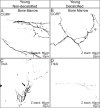The Changing Sensory and Sympathetic Innervation of the Young, Adult and Aging Mouse Femur
- PMID: 29432884
- PMCID: PMC6086773
- DOI: 10.1016/j.neuroscience.2018.01.047
The Changing Sensory and Sympathetic Innervation of the Young, Adult and Aging Mouse Femur
Abstract
Although bone is continually being remodeled and ultimately declines with aging, little is known whether similar changes occur in the sensory and sympathetic nerve fibers that innervate bone. Here, immunohistochemistry and confocal microscopy were used to examine changes in the sensory and sympathetic nerve fibers that innervate the young (10 days post-partum), adult (3 months) and aging (24 months) C57Bl/6 mouse femur. In all three ages examined, the periosteum was the most densely innervated bone compartment. With aging, the total number of sensory and sympathetic nerve fibers clearly declines as the cambium layer of the periosteum dramatically thins. Yet even in the aging femur, there remains a dense sensory and sympathetic innervation of the periosteum. In cortical bone, sensory and sympathetic nerve fibers are largely confined to vascularized Haversian canals and while there is no significant decline in the density of sensory fibers, there was a 75% reduction in sympathetic nerve fibers in the aging vs. adult cortical bone. In contrast, in the bone marrow the overall density/unit area of both sensory and sympathetic nerve fibers appeared to remain largely unchanged across the lifespan. The preferential preservation of sensory nerve fibers suggests that even as bone itself undergoes a marked decline with age, the nociceptors that detect injury and signal skeletal pain remain relatively intact.
Keywords: genetic disorders; geriatric; nociceptors; pediatric; skeletal.
Copyright © 2018 The Author(s). Published by Elsevier Ltd.. All rights reserved.
Conflict of interest statement
All other authors report no conflict of interest.
Figures





Similar articles
-
Origins of skeletal pain: sensory and sympathetic innervation of the mouse femur.Neuroscience. 2002;113(1):155-66. doi: 10.1016/s0306-4522(02)00165-3. Neuroscience. 2002. PMID: 12123694
-
A phenotypically restricted set of primary afferent nerve fibers innervate the bone versus skin: therapeutic opportunity for treating skeletal pain.Bone. 2010 Feb;46(2):306-13. doi: 10.1016/j.bone.2009.09.013. Epub 2009 Sep 18. Bone. 2010. PMID: 19766746 Free PMC article.
-
The majority of myelinated and unmyelinated sensory nerve fibers that innervate bone express the tropomyosin receptor kinase A.Neuroscience. 2011 Mar 31;178:196-207. doi: 10.1016/j.neuroscience.2011.01.039. Epub 2011 Jan 26. Neuroscience. 2011. PMID: 21277945 Free PMC article.
-
[Control of bone remodeling by nervous system. Nerve distribution and pain in bone tissue].Clin Calcium. 2010 Dec;20(12):1793-9. Clin Calcium. 2010. PMID: 21123930 Review. Japanese.
-
Noradrenergic and peptidergic innervation of lymphoid tissue.J Immunol. 1985 Aug;135(2 Suppl):755s-765s. J Immunol. 1985. PMID: 2861231 Review.
Cited by
-
Neurovascular coupling in bone regeneration.Exp Mol Med. 2022 Nov;54(11):1844-1849. doi: 10.1038/s12276-022-00899-6. Epub 2022 Nov 29. Exp Mol Med. 2022. PMID: 36446849 Free PMC article. Review.
-
Skeletal interoception in bone homeostasis and pain.Cell Metab. 2022 Dec 6;34(12):1914-1931. doi: 10.1016/j.cmet.2022.09.025. Epub 2022 Oct 17. Cell Metab. 2022. PMID: 36257317 Free PMC article. Review.
-
Similarities Between Disuse and Age-Induced Bone Loss.J Bone Miner Res. 2022 Aug;37(8):1417-1434. doi: 10.1002/jbmr.4643. Epub 2022 Jul 28. J Bone Miner Res. 2022. PMID: 35773785 Free PMC article. Review.
-
From pain to tumor immunity: influence of peripheral sensory neurons in cancer.Front Immunol. 2024 Feb 16;15:1335387. doi: 10.3389/fimmu.2024.1335387. eCollection 2024. Front Immunol. 2024. PMID: 38433844 Free PMC article. Review.
-
3D imaging reveals changes in the neurovascular architecture of the murine calvarium with aging.Bone Res. 2025 Feb 21;13(1):24. doi: 10.1038/s41413-025-00401-8. Bone Res. 2025. PMID: 39984434 Free PMC article.
References
-
- Allen MR, Hock JM, Burr DB. Periosteum: biology, regulation, and response to osteoporosis therapies. Bone. 2004;35(5):1003–1012. - PubMed
-
- Arnold W. Immunohistochemical investigation of the human inner ear. Limitations and prospects. Acta Otolaryngol. 1988;105(5–6):392–397. - PubMed
-
- Aso K, Ikeuchi M, Izumi M, Sugimura N, Kato T, Ushida T, Tani T. Nociceptive phenotype of dorsal root ganglia neurons innervating the subchondral bone in rat knee joints. Eur J Pain. 2014;18(2):174–181. - PubMed
Publication types
MeSH terms
Grants and funding
LinkOut - more resources
Full Text Sources
Other Literature Sources
Medical

